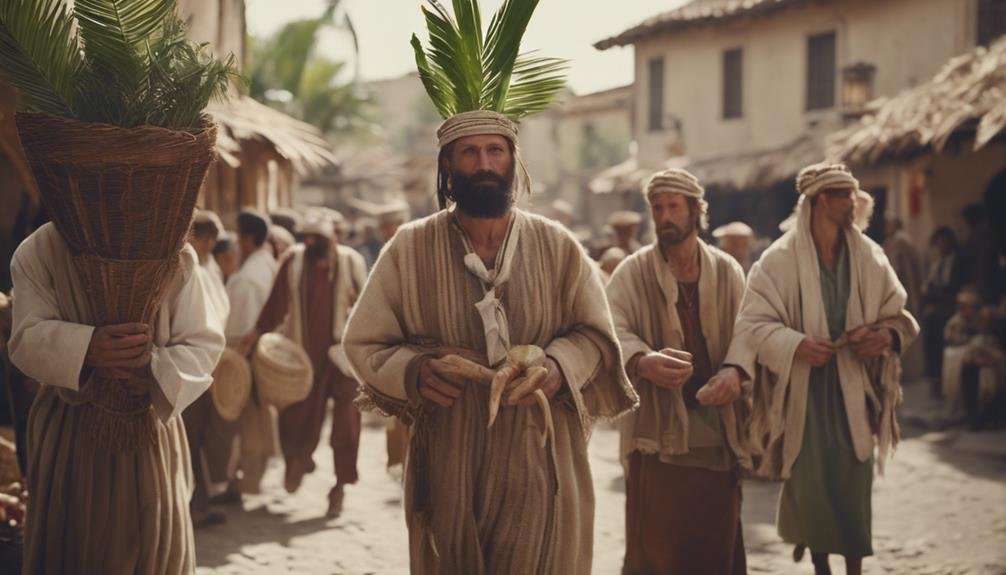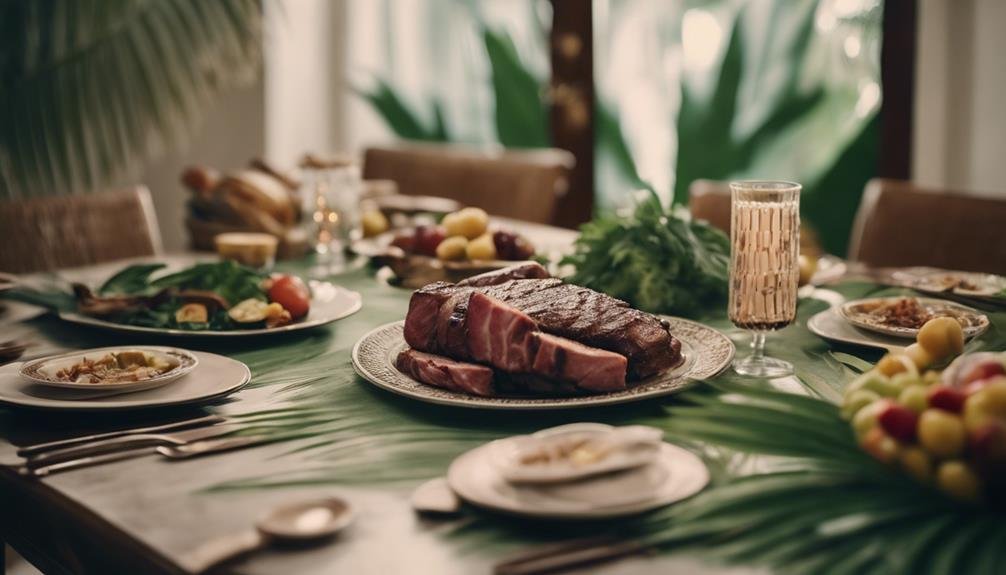As you approach Palm Sunday, you might wonder whether including meat in your meal is acceptable. While some Christian denominations, such as the Eastern Orthodox Church, traditionally abstain from meat during the entire Lenten period, others, like the Roman Catholics, don’t impose such restrictions on Palm Sunday.
This variation in practice isn’t just a matter of personal or communal piety and reflects deeper theological and cultural underpinnings that might not be immediately apparent.
Unpacking these differences could broaden your understanding of Christian traditions and influence how you observe this significant day in the Christian calendar. What other nuances exist in the observance of Palm Sunday across different cultures and denominations?
Key Takeaways
- Roman Catholics are allowed to consume meat on Palm Sunday as no specific prohibitions exist.
- Eastern Orthodox Christians traditionally abstain from meat during Great Lent, which includes Palm Sunday.
- Anglican, Lutheran, and Methodist denominations do not restrict meat consumption on Palm Sunday.
- Dietary practices vary significantly based on local traditions and individual choices within each denomination.
- Palm Sunday is generally observed to focus on reflection and celebration rather than strict dietary restrictions.
Historical Context of Palm Sunday

Palm Sunday marks the beginning of Holy Week, commemorating Jesus’ triumphant entry into Jerusalem. You’re stepping into the past when you explore this day’s history. It isn’t just about the branches; it’s deeply rooted in liturgical traditions and scriptural commemorations.
The day echoes the fulfillment of prophetic actions, marking the moment Jesus was recognized as king—a pivotal scene captured in all four Gospels.
As you investigate the origins of liturgy, you’ll find that the early Christians initiated the ritual of observance of this event in Jerusalem. The liturgical practice involved reenacting the triumphal entry, complete with palm branches, which parishioners carried to mirror the homage paid to Jesus by the ancient crowd.
This custom spread gradually across Christian territories, adapting unique local flavors but retaining the essence—a celebration of Jesus entering Jerusalem, not as a warrior king but as a prince of peace.
Understanding these traditions helps you grasp the profound symbolism of Palm Sunday. It’s not just a prelude to Easter; it encapsulates a moment of recognition, celebration, and deep historical significance within the Christian faith. As you observe this day, you’re part of a tradition that spans centuries, each palm frond waving a story of faith and triumph.
Dietary Traditions Explained
While exploring Palm Sunday’s historical and liturgical aspects, you may also wonder about the specific dietary customs associated with this day. Traditionally, Palm Sunday marks the beginning of Holy Week and sets the tone for the days leading up to Easter.
Fasting guidelines vary, but generally, the day isn’t bound by the strict fasting observed on Good Friday. Moderation is encouraged. In many cultures, meat is still consumed on Palm Sunday, but often in smaller quantities.
For instance, you might opt for a lighter dish with meat as a side or a smaller component instead of a heavy meat-based meal. This nod towards restraint reflects the solemnity of the week that commemorates the Passion of Christ.
If you’re leaning towards a meat-free day or are a vegetarian, plenty of vegetarian alternatives suit the spirit of Palm Sunday. Dishes like stuffed bell peppers, vegetable lasagna, or a hearty lentil soup can be satisfying and appropriate for the occasion. These alternatives not only adhere to a more modest approach to eating but also align with the reflective nature of the day.
Variations Across Christian Denominations

Christian denominations observe Palm Sunday with varying dietary customs, reflecting their unique theological perspectives and traditions. Whether you’re part of a denomination that allows meat consumption today depends largely on these established customs.
For Roman Catholics, the liturgical colors of red or deep purple are prominent, symbolizing the passion of Christ. You’ll find that meat isn’t prohibited on Palm Sunday so that you can partake in your usual Sunday roast. Service timings might vary, with some parishes offering additional services to accommodate the larger crowds, but this doesn’t affect dietary restrictions.
In contrast, many Eastern Orthodox churches adopted a stricter approach during the Great Lent leading up to Palm Sunday, including complete meat abstinence. Their liturgical colors often include gold or yellow, representing victory, which is prominent during the Palm Sunday service.
You’ll notice that service timings are also likely longer, incorporating the blessing of the palms and willows, reflecting deeper liturgical involvement.
If you belong to the Anglican, Lutheran, or Methodist traditions, you’ll find that there’s no specific restriction against eating meat. These denominations focus more on the symbolic nature of Palm Sunday through their liturgical practices rather than imposing dietary restrictions.
Cultural Influences on Dietary Practices
Cultural traditions also significantly shape the dietary customs observed on Palm Sunday across different regions. Depending on where you are, local beliefs and historical practices can greatly impact what’s on your plate during this significant day in the Christian calendar.
In many cultures, religious fasting during Lent leads to Palm Sunday, which might affect whether meat is consumed. For instance, in Mediterranean countries, you’ll often find that seafood replaces meat dishes as part of the fast.
Further, the integration of global cuisines has introduced a variety of practices. In some Latin American countries, traditional dishes that include meat are prepared specifically for Palm Sunday, reflecting a more relaxed fasting rule. Contrast this with Eastern European nations, where strict adherence to a meat-free diet is common until Easter Sunday.
You’ll also find that in many places, the communal aspect of eating takes precedence. Meals are often designed to unite people, reflecting a celebration of religious observance and cultural heritage. So, while the specifics of what you can eat might vary, the underlying theme is often about unity and tradition.
Common Misconceptions Addressed

Many people mistakenly believe meat cannot be consumed on Palm Sunday, but this varies widely depending on regional and denominational practices. You might’ve heard different versions of what’s appropriate, but discerning fasting rules from secular myths is crucial. Specific denominations often dictate fasting rules, which can vary substantially.
On the other hand, secular myths about Palm Sunday practices can confuse these religious guidelines. Common myths might suggest that not eating meat on Palm Sunday is universally practiced, which isn’t accurate. You must check with your local church or community for precise practices.
Here’s a quick look at some common misconceptions and their realities:
| Misconception | Reality |
|---|---|
| Meat is universally forbidden | Depends on denomination and regional practices |
| All Christians fast on Palm Sunday | Fasting rules vary; not all denominations require it |
| Palm Sunday is a day of strictness | Many observe it as a day of celebration and reflection |
| Secular traditions influence fasting rules | Often, fasting is purely religious without secular influence |
| No exceptions for dietary needs | Most denominations consider health and nutritional needs |
Understanding these distinctions helps you navigate the day more informed and aligned with your personal or communal beliefs.
Tips for Observing Palm Sunday
Now that we’ve clarified some common misconceptions let’s explore practical ways to observe Palm Sunday. Initially, you should focus on the special church decorations common on this day.
You can participate by bringing your palm branches to church or helping to decorate the sanctuary. Next, explore the different prayer types suited for Palm Sunday. Start with prayers of praise and adoration, reflecting the joyful celebration of Jesus’ arrival.
You can also engage in confessional prayers considering the sad reality of the upcoming Holy Week. Don’t forget to include intercessory prayers, asking for peace and blessings for your community and the world.
Additionally, you can read Bible passages related to Palm Sunday, such as the account of Jesus entering Jerusalem in the Gospels. This will deepen your understanding and connection to the day’s significance.
Conclusion
On Palm Sunday, your choice to eat meat depends on your denomination and personal beliefs. Roman Catholics typically have no restrictions, while Eastern Orthodox adhere to a strict no-meat rule during Lent. Other denominations like Anglican or Lutheran mightn’t set specific guidelines.
Always consider your community’s traditions and cultural influences when deciding. If you’re unsure, consult with your church leaders or more knowledgeable members of your community.
Related Articles:
7 Best Online Streams for Sunday Church Services
10 Online Streams for Joyful Sunday Church Services
Top 10 Sunday Church Services for a Joyful Celebration

